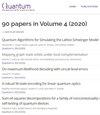Resource Marginal Problems
IF 5.1
2区 物理与天体物理
Q1 PHYSICS, MULTIDISCIPLINARY
引用次数: 0
Abstract
We introduce the $\textit{resource marginal problems}$, which concern the possibility of having a resource-free target subsystem compatible with a $given$ collection of marginal density matrices. By identifying an appropriate choice of resource R and target subsystem T, our problems reduce, respectively, to the well-known $\textit{marginal problems}$ for quantum states and the problem of determining if a given quantum system is a resource. More generally, we say that a set of marginal states is $\textit{resource-free incompatible}$ with a target subsystem T if all global states compatible with this set must result in a resourceful state in T of type R. We show that this incompatibility $induces$ a resource theory that can be quantified by a monotone and obtain necessary and sufficient conditions for this monotone to be computable as a conic program with finite optimum. We further show, via the corresponding witnesses, that (1) resource-free incompatibility is equivalent to an operational advantage in some channel-discrimination tasks, and (2) some specific cases of such tasks fully characterize the convertibility between marginal density matrices exhibiting resource-free incompatibility. Through our framework, one sees a clear connection between any marginal problem – which implicitly involves some notion of incompatibility – for quantum states and a resource theory for quantum states. We also establish a close connection between the physical relevance of resource marginal problems and the ground state properties of certain many-body Hamiltonians. In terms of application, the universality of our framework leads, for example, to a further quantitative understanding of the incompatibility associated with the recently-proposed entanglement marginal problems and entanglement transitivity problems.资源边际问题
我们引入了$\textit{资源边际问题}$,这些问题涉及是否可能有一个无资源的目标子系统与$given$边际密度矩阵集合相兼容。通过确定资源 R 和目标子系统 T 的适当选择,我们的问题分别简化为众所周知的量子态$\textit{边际问题}$ 和确定给定量子系统是否是资源的问题。更一般地说,如果所有与边际态集兼容的全局态都会在 T 中产生一个 R 类型的资源态,那么我们就说边际态集与目标子系统 T 是 $\textit{无资源不兼容}$。我们证明了这种不兼容会引起一个可以用单调来量化的资源理论,并得到了这个单调可以作为具有有限最优的圆锥程序来计算的必要条件和充分条件。通过相应的证明,我们进一步证明:(1) 在某些渠道区分任务中,无资源不相容等同于操作优势;(2) 在此类任务的某些特定情况下,表现出无资源不相容的边际密度矩阵之间的可转换性是完全表征的。通过我们的框架,我们可以看到量子态的任何边际问题(其中隐含着某种不相容的概念)与量子态资源理论之间的明确联系。我们还在资源边际问题的物理意义与某些多体哈密顿的基态性质之间建立了密切联系。在应用方面,我们框架的普遍性导致了对最近提出的纠缠边际问题和纠缠反式问题相关的不相容性的进一步定量理解。
本文章由计算机程序翻译,如有差异,请以英文原文为准。
求助全文
约1分钟内获得全文
求助全文
来源期刊

Quantum
Physics and Astronomy-Physics and Astronomy (miscellaneous)
CiteScore
9.20
自引率
10.90%
发文量
241
审稿时长
16 weeks
期刊介绍:
Quantum is an open-access peer-reviewed journal for quantum science and related fields. Quantum is non-profit and community-run: an effort by researchers and for researchers to make science more open and publishing more transparent and efficient.
 求助内容:
求助内容: 应助结果提醒方式:
应助结果提醒方式:


